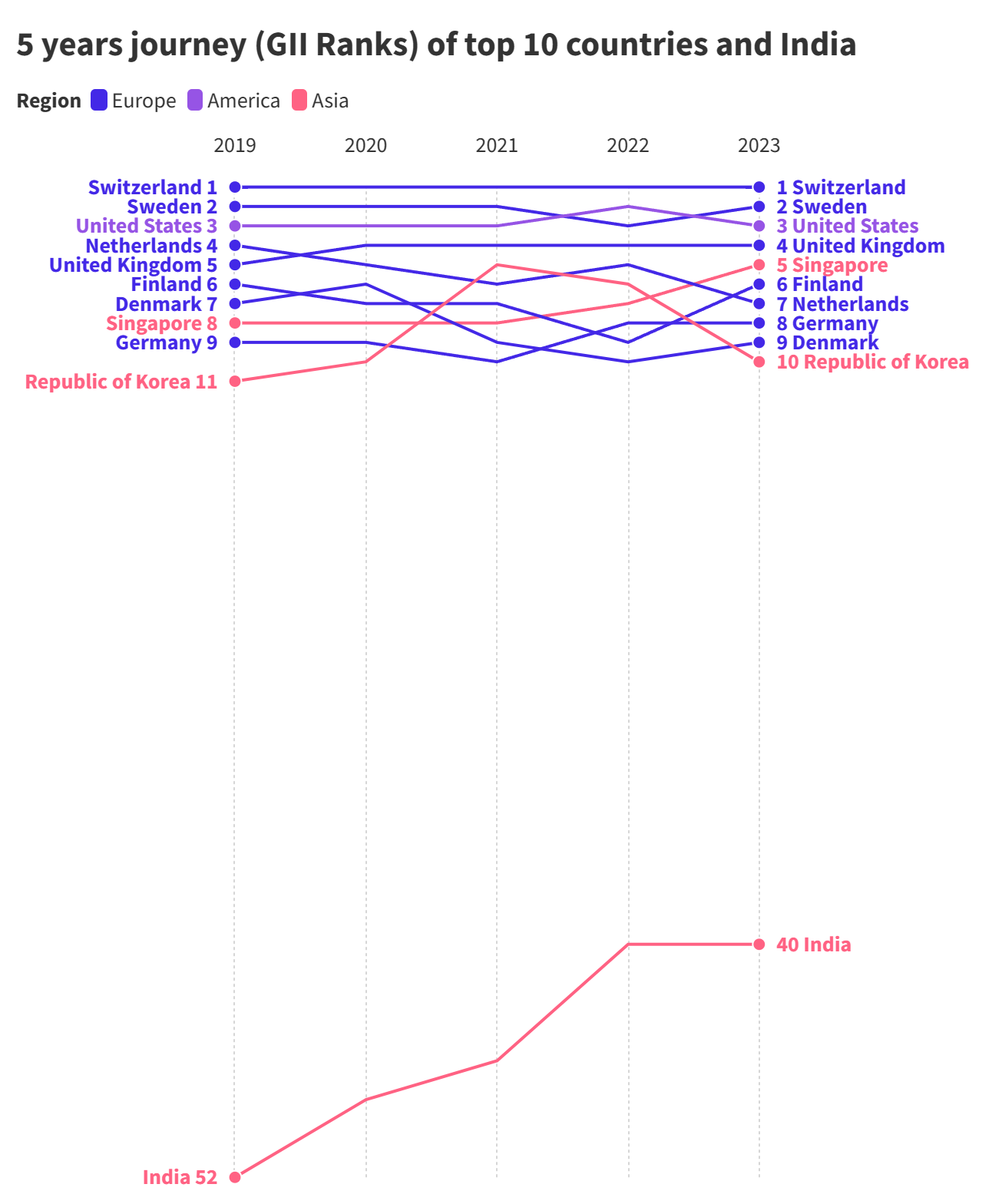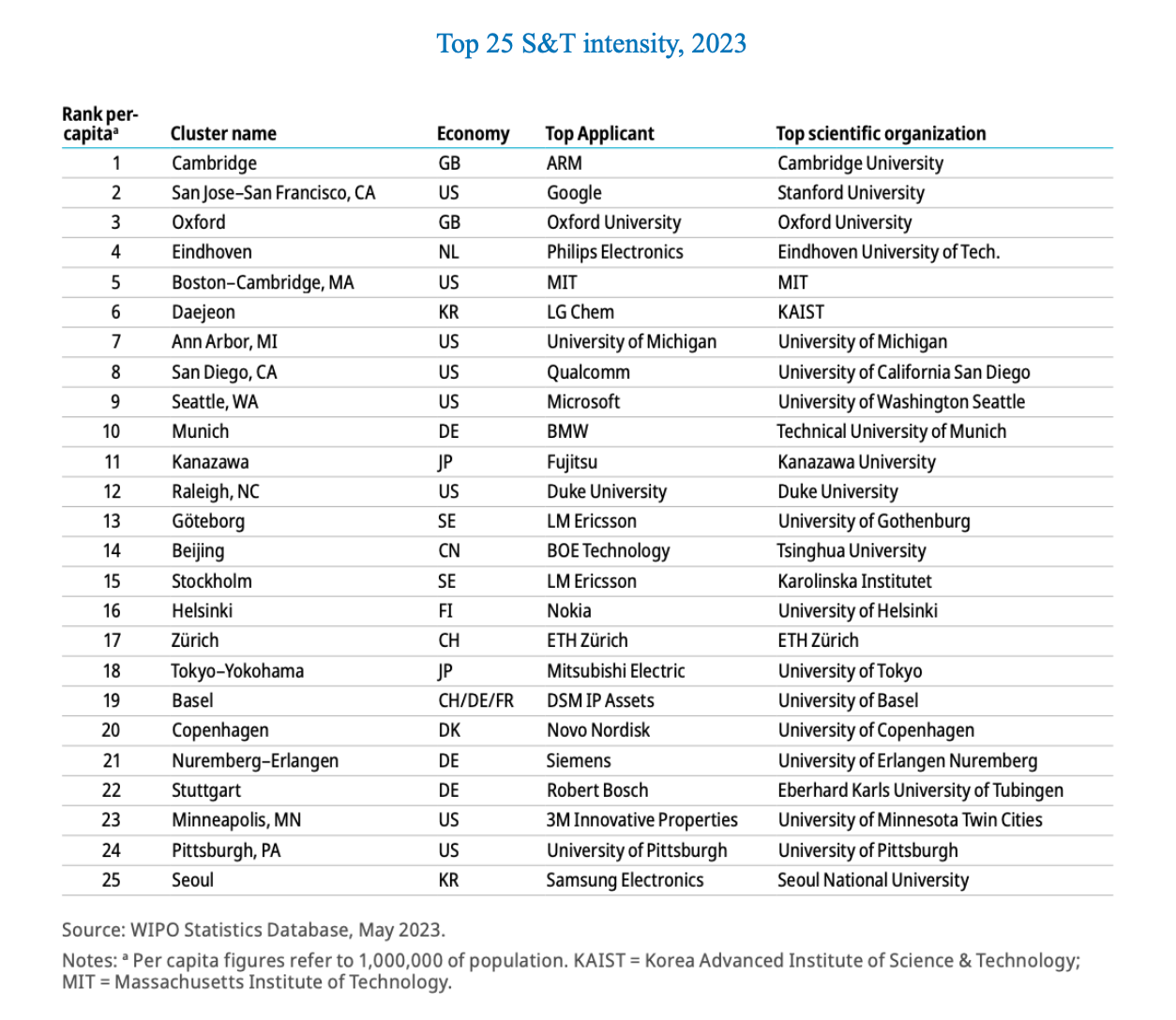Innovative Universities Lead To Innovative Economies: Evidence from Global Innovation Index and Nature Index
The Global Innovation Index 2023 was released last week by the World Intellectual Property Organisation. Out of 132 economies, India ranked 40th. Switzerland remains the world’s leader in innovation.

The Global Innovation Index 2023 was released last week by the World Intellectual Property Organisation. Out of 132 economies, India ranked 40th. Switzerland remains the world’s leader in innovation for the 13th consecutive year followed by Sweden, the United States, the United Kingdom, and Singapore. India has made significant improvement in the past decade as it ranked 81st in 2015, India’s performance in different pillars over the years:

The article tries to assess the top 10 countries of the GII and look at the top 100 institutions from the Nature’s Patent Index which was released in 2022. The Nature Patent Metric is a tool developed by Nature to rank academic institutions based on the quality and number of patents they have filed in the past five years. It is a valuable tool for assessing the innovative output of academic institutions, providing a more accurate reflection of innovation output than other metrics. The Nature Index is a database of research output used to assess research performance and identify potential collaborations and partnerships, tracking contributions to research articles published in high-quality natural science journals.

Universities are known for their ability to create both basic and applied research, which is closely intertwined. This knowledge creation is considered a valuable public good. In addition to their direct impact on innovation, universities also generate positive spillovers through technology transfers, which enhance firms' internal R&D capabilities. Since relying solely on internal R&D departments can be challenging for firms, they may need to open up their innovation process and collaborate with external partners to access diverse expertise and resources. The popular choice for these external partners has been universities and research institutions.

If we look at the top 10 economies in the world, almost every country has institutions in the top 100 of Nature’s Innovative Index. What this tells us is that universities, together with public R&D labs and science agencies, public policies and business enterprises are now considered important actors in the economies. The universities play a pivotal role in fueling innovation, which in turn drives economic growth and raises living standards in the United States. U.S. universities spend approximately $75 billion per year on research which is slightly more than Rs 6 trillion, amounting to 13 per cent of America’s total spending on research and development (R&D).
In 2022, European startups raised over $12 billion in funding. Northern European countries have been particularly successful in securing investment on a per capita basis. Iceland had the highest investment per capita of approximately €500, showcasing a growing startup ecosystem with a focus on food, energy, and healthcare. Sweden secured approximately €570 per capita, boasting a thriving tech scene, substantial investment in research and development, and an educated talent pool. Switzerland had around €440 per capita in startup funding with a thriving tech scene in fintech and blockchain. The United Kingdom had an investment rate per person of just under €465 and a successful fintech hub in London, despite external challenges like political uncertainty and Brexit. Finland saw a record-breaking year in 2022 with an investment rate of about €335 per person, recognised for its innovation and embracing of green technologies.

Universities and venture capital firms have a mutually beneficial relationship that fosters innovation and economic growth. Universities are important centres for research, innovation, and the creation of intellectual property. They produce cutting-edge technologies and inventions through academic research, which venture capital firms recognise as having great potential. Collaboration between universities and venture capital firms takes different forms, including joint research projects, licensing agreements, and direct investment in university research startups. Universities facilitate the commercialisation of academic discoveries through their technology transfer offices, while venture capital firms provide the necessary capital and expertise to develop, scale, and market these technologies effectively. The collaboration between universities and venture capital firms not only drives the growth of startups but also contributes to the broader dissemination of knowledge and advancements, promoting both societal and economic progress.

The Global Innovation Index of 2023 highlights that innovation output at the local level is as important as national output. The report identifies the top 100 science and technology clusters worldwide, which are geographic areas with a high concentration of inventors and scientific authors. Clusters in Europe and the United States exhibit a higher intensity of S&T activity than those in Asia. The United States has eight clusters in the top 25, followed by Germany with three clusters (including Munich, which moved up to the 10th spot), and the United Kingdom, Japan, the Republic of Korea, and Sweden, each with two clusters. Cambridge and Oxford are among the top three rankings by intensity in the United Kingdom, while Kanazawa and Tokyo-Yokohama improved their ranking in Japan. Seoul entered the top 25 in the Republic of Korea, whereas Lund-Malmö dropped out of the top 25 in Sweden.

The Global Innovation Index 2023 highlights India's remarkable progress in the field of innovation, with a notable improvement However, it also underscores the urgent need for reform in the higher education system to foster a culture of innovation in the country. The success stories of top-ranked economies demonstrate the pivotal role of universities in driving innovation and economic growth. Initiatives like sharing patent rights and reduced fees for patent filing are steps in the right direction toward realising India's potential as a global innovation powerhouse but a lot more needs to be done in order to make the country a soft power in terms of innovation and research.
Written by Shivani, Visualisation by Bhupesh for the IP Wave.
.






